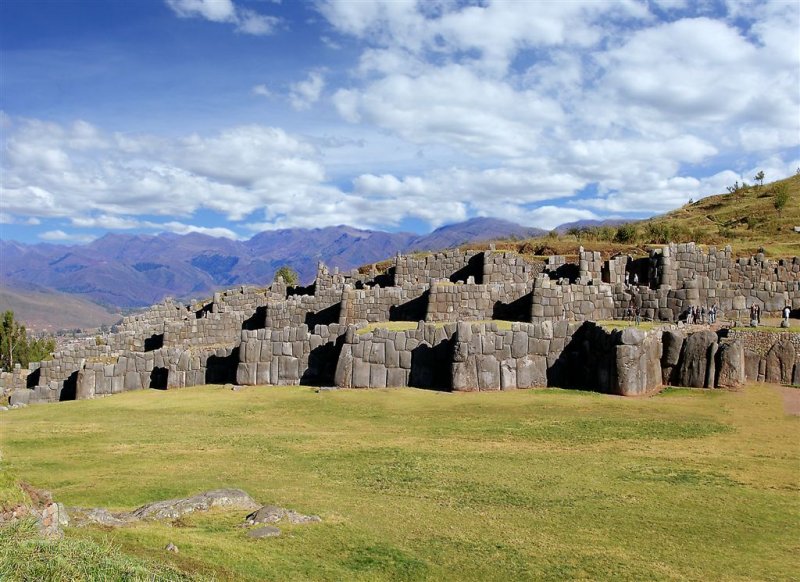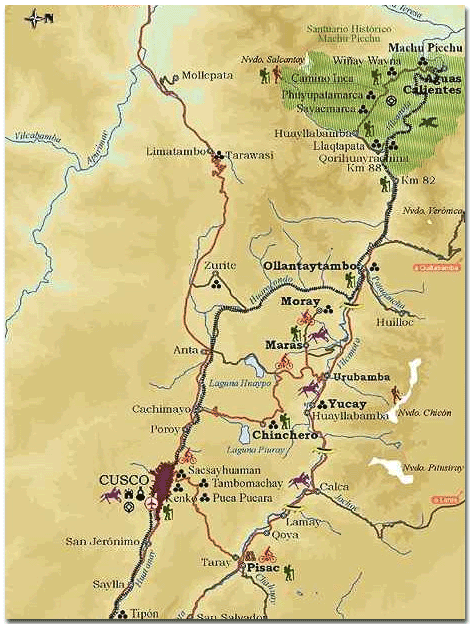Temple of Ancient Idols and Mummies Discovered in Peru
posted on July 24th, 2008 in Andes Mountains, Archaeology, Cuzco: Information about the former Inca capital, Incas, Peru, Peruvian Mummies, Recent Discoveries
(Above: The Inca ruins of Sacsayhuaman (also Saqsaywaman) lie just above the city of Cuzco, Peru, at an elevation of nearly 12,000 feet)
Ancient Temple Discovered Among Inca Ruins
National Geographic News
March 31, 2008
A temple thought to have once housed idols and mummies has been unearthed near an ancient Inca site in Cusco, Peru…
The temple was discovered outside the ruins of a stone fortress known as Sacsayhuaman, which is thought to have been built by a pre-Inca culture called the Killke around 1100 A.D.
The fortress was later occupied and expanded by the Inca, experts say, and its ruins are now a UN World Heritage site.
Scientists who found the temple say its discovery upends theories that the Sacsayhuaman complex was used strictly for military purposes.
“We are in the process of investigating, but we are very excited about what we have found,” said Washington Camacho, director of the Sacsayhuaman Archaeological Park.
“We believe that the temple we have found was used for ceremonial purposes.”
The temple covers some 2,700 square feet (250 square meters) and contains 11 rooms thought to have held idols and mummies, Camacho said.
The temple contained “funeral structures,” he added, and was found next to “an enormous rocky formation” that researchers speculate was used as a “sacred place” prior to the Spanish conquest in the 16th century.
Early Inca Clues
Christina Conlee, an anthropologist at Texas State University who was not part of the excavation, said that the team’s theory about the site’s ceremonial use seems valid, based on evidence cited in recent media reports.
“I think the discovery is potentially important, because although we know quite a bit about the later Inca Empire, the early Inca and origins of their culture are less well known,” she said.
“The finding of an earlier temple near Sacsayhuaman seems to suggest this was a sacred area in pre-imperial times.”
Researchers also discovered an ancient footpath or roadway that Camacho said was built during the period of Inca occupation.
“The path connected the fort at Sacsayhuaman with Lake Cochapata,” Camacho said.
The roadway was lined with walls of mud and ran approximately 0.25 to 0.3 mile (400 to 500 meters) throughout the complex, Camacho said.
Archaeologists also detected traces of an ancient but simple aqueduct system, a type of gutter that ran alongside the road, possibly supplying water to the ancient city of Cusco.
Brian Bauer, an expert on the Inca at the University of Illinois, Chicago, said the newfound temple expands the known size of the Sacsayhuaman complex.
“The [National Institute of Culture] in Peru has been conducting a series of large scale excavations at Sacsayhuaman for several years,” he said.
“This was one of the most important areas of ancient Cusco, and we know that there are early Inca remains there as well.
“The exact function of those earlier remains is unclear, but it is exciting that the complex appears to have been larger than previously thought.”
(Below: A map showing the Inca ruins of Sacsayhuaman just to the right of Cuzco, along with other Inca ruins in the region, including those of Machu Picchu)


